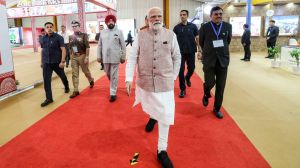Revised obesity guidelines focus on abdominal fat
Newer research highlights the shortcomings of using BMI alone to accurately diagnose obesity, especially for Indians.
 The new guidelines focus on abdominal obesity, as abdominal fat is closely linked to insulin resistance and prevalent in Indians. (Source: Unsplash)
The new guidelines focus on abdominal obesity, as abdominal fat is closely linked to insulin resistance and prevalent in Indians. (Source: Unsplash)A landmark analysis conducted by the National Diabetes Obesity and Cholesterol Foundation (N-DOC), Fortis C-DOC Hospital for Diabetes and Allied Sciences, and All India Institute of Medical Sciences (AIIMS) has redefined obesity for the Indian population.
The need for updated obesity guidelines stems from several critical factors. The previous guidelines for obesity in Asian Indians, established in 2009 (lead author professor Anoop Misra), relied exclusively on Body Mass Index (BMI, a ratio of weight in kg/height in square metre) for diagnosis. Newer research highlights the shortcomings of using BMI alone to accurately diagnose obesity, especially for Indians. Studies have shown a strong correlation between abdominal obesity in Asian Indians, resulting in inflammation and the early onset of comorbid diseases, prompting the need for a refined definition.
The new guidelines focus on abdominal obesity, as abdominal fat is closely linked to insulin resistance and prevalent in Indians, and is now recognised as a key factor in the diagnosis. The new definition integrates the presence of comorbidities — such as diabetes and cardiovascular disease — into the diagnostic process, ensuring that obesity-related health risks are better accounted for. There is an inclusion of mechanical problems associated with obesity, like knee and hip osteoarthritis or shortness of breath during daily activities, which produce poor quality of life.
The study introduces a two-stage classification of obesity.
Stage 1 Obesity: Increased adiposity, which is defined as accumulation of more body fat than the lean mass (BMI > 23 kg/m²), without apparent effects on organ functions or routine daily activities. This stage of obesity, currently not causing any pathological problems, could progress to Stage 2 obesity, which has an association with mechanical and disease-related problems.
Stage 2 Obesity: Advanced state of obesity with increased BMI of more than 23 kg/m², and abdominal adiposity; and excess waist circumference (WC) or waist-to-height ratio (W-HtR). One of the following impacts physical and organ functions, like knee arthritis due to excess weight or the presence of diseases associated with obesity like type 2 diabetes. The above stage (obesity with consequences) reflects that obesity hinders functions of organs of the body and makes an individual more symptomatic requiring more intensive management.
Tailored weight reduction strategies, based on the above classification, could be used in an effective and personalised manner by the use of new guidelines.
Dr Anoop Misra, Padma Shri awardee and Executive Chairman and Director of Diabetes and Endocrinology at Fortis C-DOC Hospital, said, “obesity rates in India are rising at an alarming pace, extending beyond urban areas. These guidelines are groundbreaking and easy to implement, providing stage-specific strategies for managing obesity-related conditions across India. These also allow application of weight loss therapies to be applied early and optimally”.
Dr Naval Vikram, Professor of Medicine, AIIMS, New Delhi, added, “a distinct definition of obesity for Indians is crucial for the early detection of related diseases and the development of targeted management strategies. This study fills critical gaps in our understanding and offers a clear, rational approach to tackling obesity in the Indian population”.







